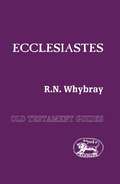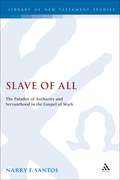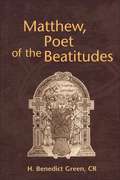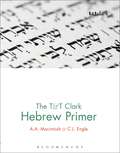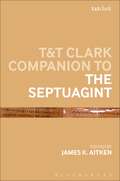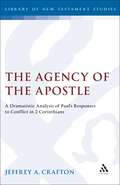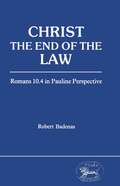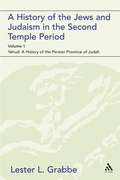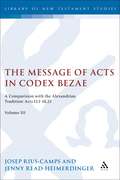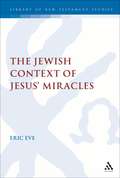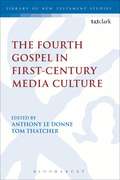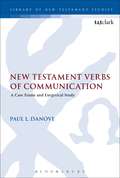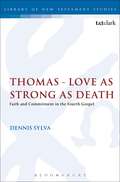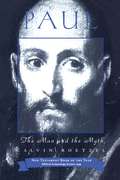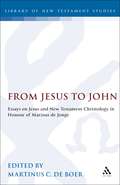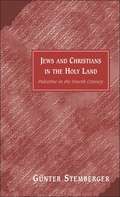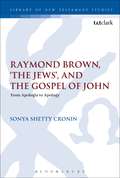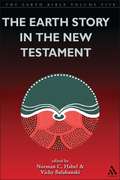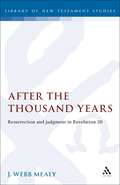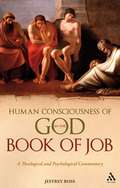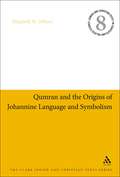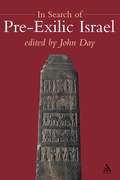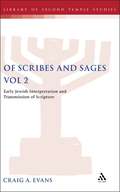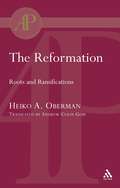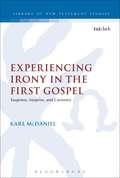- Table View
- List View
Ecclesiastes (Old Testament Guides)
by R. Norman WhybrayEcclesiastes is at once a strange book and a modern one, at once enigmatic and curiously familiar. Here we find a man detached from the world and yet intensely aware of it, setting down in writing his thoughts about human life. Yet from the very first his readers have been unable to agree about his basic attitude to life. Whybray sorts through the options by asking questions regarding the author, his times, his language and his ideas.
Slave of All: The Paradox of Authority and Servanthood in the Gospel of Mark (The Library of New Testament Studies #237)
by Narry SantosThe Gospel of Mark is often described as a paradoxical gospel, a riddle that teases its readers' response, and a narrative that possesses an enigmatic and puzzling character. Santos argues that this puzzling character is seen clearly in the paradox of authority and servanthood in the gospel. In tracing and analyzing this paradox throughout the Markan narrative, he first develops a literary method for the study of paradox, and having applied the results to authority and servanthood in Mark, he discusses key contributions of the paradox to the three Markan issues of the disciples' role in the Gospel, the Messianic Secret, and a profile of the Markan community.
Matthew, Poet of the Beatitudes (The Library of New Testament Studies #203)
by H. Benedict GreenGreen argues that the Beatitudes in Matthew's version are a carefully constructed poem, exhibiting a number of the characteristics of Hebrew poetry as we know it from the Old Testament; but as certain of these, such as rhyme and alliteration, cannot survive translation, what we have here is an original composition in Greek. This is shown to be no isolated phenomenon in the gospel; a series of texts found at specially significant points in it disclose similar characteristics. The findings cut across conventional source attributions and reveal the creative hand of the evangelist. By studying the individual beatitudes in their relation to each other as revealed by the formal structure, fresh light is thrown upon their meaning and their background in the scriptures of the Old Testament.
The T&T Clark Hebrew Primer
by A. A. Macintosh C. L. EngleLearning Biblical Hebrew can be extremely difficult. Here at last is a book designed to work in conjunction with the many Hebrew Grammars available in order to break this complex language down into bite-size chunks for revision and consolidation of key aspects of grammar, as well as vocabulary. A.A. Macintosh and C.L. Engle combine insights from teaching Hebrew in both the United States and Europe, and between them bring some fifty years of experience of teaching Hebrew to undergraduate students to this clearly structured book.
T&T Clark Companion to the Septuagint (Bloomsbury Companions)
by James K AitkenThe Septuagint is the Greek translation of the Hebrew Bible and the scriptures read by early Christians. Septuagint studies have been a growth field in the past twenty years. It has become an area of interest not only for textual criticism of the Hebrew Bible but as a product of Judaism in the Graeco-Roman world. It is even being utilized occasionally by scholars of Greek religion. At the same time renewed interest in the daughter versions (Syriac, Vulgate, Ethiopic, Coptic etc.) has thrown new attention onto the Septuagint. This Companion provides a cutting-edge survey of scholarly opinion on the Septuagint text of each biblical book. It covers the characteristics of each Septuagint book, its translation features, origins, text-critical problems and history. As such it provides a comprehensive companion to the Septuagint, featuring contributions from experts in the field.
The Agency of the Apostle: A Dramatistic Analysis of Paul's Responses to Conflict in 2 Corinthians (The Library of New Testament Studies #51)
by Jeffrey CraftonIn this interdisciplinary study Paul's enigmatic rhetoric in 2 Corinthians is analysed and explained using dramatism, a modern critical theory developed by Kenneth Burke. Three portions of 2 Corinthians are isolated and examined as fitting responses to dintinct stages in Paul's changing relationship to the Corinthian Christians. In the Letter of Initial Response (2.14-7.4), Paul responds to the beginning of the conflict with an argument defined by the opposition between 'agency' and 'agent' conceptions of ministry. In the Letter of Attack (chs. 10-13), Paul replies to the apex of the crisis by playing the role of the foolish agent in order to gain a hearing and drive the Corinthians out of their orientation. In the Letter of Reconciliation (1.3-2.13 + 7.5-16), Paul rehearses the symbolic purification which has occurred in this conflict.
Christ the End of the Law: Romans 10.4 in Pauline Perspective (The Library of New Testament Studies)
by Robert BadenasIn this close textual analysis Badenas uses the term 'telos' as his starting point to delve into a closer examination of the Greek-speaking ancient world. The study divides into three key sections: a history of exegesis, a lexical study of telos, and an exegetical study of Rom 10:4. This final part enables an in-depth analysis of the place and role of Rom 10:4 within Romans 9:11, and, in turn, of Romans 9:11 within Paul's argument more generally. In so doing, Badenas is able to offer a more informed judgement of the use of the statement 'Christ is the end of the law,' contributing insightfully to an abundance of material which proclaims the statement without acknowledgement of its greater context.
A History of the Jews and Judaism in the Second Temple Period: The Persian Period (539-331BCE) (The Library of Second Temple Studies #47)
by Lester L. GrabbeIn the first of four volumes on A History of the Jews and Judaism in the Second Temple Period, Lester Grabbe presents a comprehensive history of Yehud - the Aramaic name for Judah - during the Persian Period. Among the many crucial questions he addresses are: What are the sources for this period and how do we evaluate them? And how do we make them 'speak' to us through the fog of centuries? This first volume, Yehud: A History of the Persian Province of Judah offers the most up to date and comprehensive examination of the political and administrative structures; the society and economy; the religion, temple and cult; the developments in thought and literature; and the major political events of Judah at the time.
The Message of Acts in Codex Bezae: A Comparison with the Alexandrian Tradition: Acts 13.1-18.23 (The Library of New Testament Studies #365)
by Josep Rius-Camps Jenny Read-HeimerdingerThe third volume in the four-volume commentary on the Book of Acts, this work presents a fresh look at the text of Codex Bezae and compares its message with that of the more familiar Alexandrian text of which Codex Vaticanus is taken as a representative. It deals with Acts 13.1-18.23, the chapters that cover the first two stages of the mission to the Gentiles, with the intervening meeting in Jerusalem (14.28-15.41). For each section, there is a side by side translation of the Bezan and Vaticanus manuscripts, followed by a full critical apparatus which deals with more technical matters, and finally, a commentary which explores in detail the differences in the message of the two texts. Of particular interest in this part of Acts are the person of Paul and the unfolding of his character and theology. It is found that in the Bezan text Luke portrays him as a fallible disciple of Jesus who, despite his powerful enthusiasm, is hindered by his traditional Jewish understanding from fully carrying out the mission entrusted to him in these first stages. The conclusion is drawn that the portrait of an exemplary hero in the Alexandrian text is a later modification of the flawed picture.
The Jewish Context of Jesus' Miracles (The Library of New Testament Studies #231)
by Eric EveScholarly literature on Jesus has often attempted to relate his miracles to their Jewish context, but that context has not been surveyed in its own right. This volume fills that gap by examining both the ideas on miracle in Second Temple literature (including Josephus, Philo, the Dead Sea Scrolls, Apocrypha and Pseudepigrapha) and the evidence for contemporary Jewish miracle workers. The penultimate chapter explores insights from cultural anthropology to round out the picture obtained from the literary evidence, and the study concludes that Jesus is distinctive as a miracle-worker in his Jewish context while nevertheless fitting into it.
The Fourth Gospel in First-Century Media Culture (The Library of New Testament Studies #426)
by Anthony Le Donne Tom ThatcherThis book examines the Fourth Gospel in reference to First-Century media culture, including issues of issues of orality, aurality and performance.
New Testament Verbs of Communication: A Case Frame and Exegetical Study (The Library of New Testament Studies #520)
by Paul L. DanovePaul Danove builds upon his previous work in the field of biblical linguistics to provide a refinement to the method of Case Frame analysis as applied to the Greek of the New Testament. He also shows how the method can be used in clarifying elements of Greek grammar, interpretation, and translation. In particular Danove distinguishes the semantic implications of active, middle, and passive usages of verbs. He establishes a rigorous basis for distinguishing semantic synonyms and near-synonyms and for clarifying their implications for interpretation and translation. Additionally, he generates an heuristic feature model for relating distinct usages of verbs and deriving their various connotations, and he seeks to clarify the conceptual and grammatical differences of verbs of oral and non-oral communication.
Thomas - Love as Strong as Death: Faith and Commitment in the Fourth Gospel (The Library of New Testament Studies #434)
by Dennis SylvaThomas appears only four times in John's Gospel, yet despite this he is crucially important in understanding the function of the Johannine message. Dennis Sylva provides the first major study which examines the paradox that Thomas is both opposed to a dominant theme in the Fourth Gospel - the eternal life that is a gift to Jesus' followers - and yet is in support of Jesus himself.Thomas appears to have a foot on both sides of the Johannine dualistic divide. He seems to be existentially at home on one side and yet ideologically at home on the other. No other character in John's Gospel so tenaciously hold on to companionship with Jesus while just as resolutely distancing himself from Jesus' central teaching. Thomas breaks down the barriers between the disciples (those who walk in the light) and the world (those who walk in the darkness) that John takes pains to establish. Sylva's new work demonstrates the importance of Thomas in fully understanding the message of the Fourth Gospel.
Paul: The Man And The Myth
by Calvin J. RoetzelWinner of 'New Testament Book of the Year, Biblical Archaeology Society 1999' A masterly new evaluation of Paul: the man, his work and his world. Professor Roetzel breaks new ground in exploring some aspects of Paul which have remained shadowy: his sexual asceticism, his preoccupation with holiness - Holy Spirit, holy community and holy ethos - the evolution of his theology, and his emergence as a legendary figure. Roetzel also furthers our understanding of the culture, the social world and the political realities of Paul's time.
From Jesus to John: Essays on Jesus and New Testament Christology in Honour of Marinus de Jonge (The Library of New Testament Studies #84)
by Martinus C. de BoerMarinus de Jonge was Professor of New Testament and Early Christian Literature at Leiden from 1966 to 1991. A former president of Studiorum Novi Testamenti Societas, the International Society of New Testament scholars, he is best known for his work on the 'Testaments of the Twelve Patriarchs' and on the Gospel and Epistles of John. More recently his work on Jesus and early Christology has received critical acclaim: 'Christology in Context. The Earliest Christian Response to Jesus' (1988) and 'Jesus: The Servant-Messiah' (1991). This volume of essays in his honour from a team of international scholars and admirers (from Holland, Great Britain, the United States, Norway and Germany) recognizes his singular and provocative contributions to our understanding of Jesus and New Testament Christology. The essays cover such topics as Jesus' self-understanding, the christological ascriptions of his earliest disciples and followers, the background to New Testament Christology in Judaism, the Christology of Paul, and the Christology of the Gospels, especially John. Together these essays constitute a significant contribution to the discussion about Jesus and the Christology of the earliest Christians.
Jews and Christians in the Holy Land: Palestine in the Fourth Century
by Gunter StembergerThe fourth century is often referred to as the first Christian century, and for the Jews a period of decline and persecution. But was this change really so immediate and irreversible? What was the real impact of the Christianisation of the Roman Empire on the Jews, especially in their own land?Stemberger draws on all available sources, literary and archaeological, Christian as well as pagan and Jewish, to reconstruct the history of the different religious communities of Palestine in the fourth century.This book demonstrates how lively, creative and resourceful the Jewish communities remained.
Raymond Brown, 'The Jews,' and the Gospel of John: From Apologia to Apology (The Library of New Testament Studies #504)
by Sonya Shetty CroninUntil the mid-1960s, most commentators of the Gospel of John were aware of a polemic against 'the Jews,' yet they did not consider it with reference to contemporary ethical discussion. A shift in focus in Johannine scholarship is noticeable from the mid-1960s and 1970s to the present, where commentators began to connect the Gospel's polemic against 'the Jews' with potential anti-Judaism in the text. As yet, very little work has been done to answer the question of how this change in sensitivity came about. This book is a historiography of one scholar's growing awareness of potential anti-Judaism in the Gospel of John with the intention of using this individual history to explain the larger trend in biblical studies. Sonya Cronin examines the published work of Raymond Brown, a prominent Catholic New Testament scholar, between the years 1960-1998. The book contextualizes Brown's work by evaluating the impact of ecclesiastical statements and the influence of earlier and contemporary Johannine scholarship on Brown's biblical interpretation, and then posits theories as to why change occurs at specific times.
The Earth Story in the New Testament: Volume 5
by Vicky Balabanski Norman C. HabelThe "Earth Bible" is an international project, including volumes on ecojustice readings of major sections of the Bible. The basic aims of the Earth Bible project are: to develop ecojustice principles appropriate to an Earth hermeneutic for interpreting the Bible and for promoting justice and healing for Earth; to publish these interpretations as contributions to the current debate on ecology, ecoethics and ecotheology; to provide a responsible forum within which the suppressed voice of Earth may be heard and impulses for healing Earth may be generated. The project explores text and tradition from the perspective of Earth, employing a set of ecojustice principles developed in consultation with ecologists, suspecting that the text and/or its interpreters may be anthropocentric and not geocentric, but searching to retrieve alternative traditions that hear the voice of Earth and value Earth as more than a human instrument. The lead article in Volume V is a reflection in responses to the ecojustice principles employed in the hermeneutic of the project. Several articles offer insights into New Testament texts that seem to devalue Earth in favour of heaven. The final article by Barbara Rossing challenges the popular apocalyptic notion that in the new age Earth will be terminated. A feature of this volume is a dialogue between Norman Habel, who argues that John One seems to devalue Earth, and two respondents, Elaine Wainwright and Vicky Balabanski (who is coeditor of this volume with Norman Habel). 1
After the Thousand Years: Resurrection and Judgment in Revelation 20 (The Library of New Testament Studies #70)
by J. Webb MealyA fresh and highly illuminating approach to what is perhaps the most difficult chapter in the most difficult book of the New Testament. Mealy employs a carefully developed methodology which draws fully on the special literary techniques of Revelation, particularly its extensive use of internal cross-references, multivalent images and symbols, and complex Old Testament reminiscences. With its central thesis that Revelation 20.7-10 and 20.11-15 offer parallel representations of the resurrection and final judgment of the unrepentant, this study is destined to become a benchmark for future discussions not only of the millennium, but of the literary workings of Revelation as a whole.
Human Consciousness of God in the Book of Job: A Theological and Psychological Commentary
by Jeffrey BossHuman Consciousness of God is the first commentary on the book of Job to trace Job's relationship with God in a work of universal sprituality. The most important - and unique - element in Jeffrey Boss' approach is his examination of Job from a psychological perspective. However the work also takes into account the history of interpretation of the book, giving due attention to questions surrounding the text's coherence, authorship and provenance. It is, at the same time, a valuable new commentary on the Hebrew Masoretic Text of Job. The book opens with an introduction enabling those unfamiliar with the book of Job, or with recent scholarship to appreciate it and engage with it. Then follows the full commentary which draws attention to the development of Job's character and his relationship with God. Finally the author presents his conclusions following the work together with a detailed bibliography.
Qumran and the Origins of Johannine Language and Symbolism (Jewish and Christian Texts)
by Elizabeth W. MburuThis work sets out to demonstrate that the sectarian Qumran document The Rule of the Community, provides linguistic clues which illuminate our understanding of how the author of the Fourth Gospel used truth terminology and expected it to be understood. It establishes that there are significant linguistic similarities shared by these two corpora. While these may be attributed to a development of the common tradition shared by both, as well as the influence ideology, the semantic continuity with the Rule of the Community makes it likely that the author of the Fourth Gospel was familiar with the mode of thought represented in the linguistic matrix of the Qumran literature and that he followed this in articulating his ideas in certain parts of his Gospel.
In Search of Pre-Exilic Israel: In Search Of Pre-exilic Israel (The Library of Hebrew Bible/Old Testament Studies)
by John DayIn recent years there has been a tendency among certain scholars to claim that little can be known about pre-exilic Israel, because the Old Testament was only compiled in the post-exilic period (for example Philip Davies, Thomas Thompson, Neils Peter Lemche). One scholar (Lemche) has even claimed that the Old Testament is a Hellenistic work. The purpose of this book is to argue that this is an extreme and untenable position and that, though much of the Old Testament was indeed edited in the exilic or post-exilic period, many of the underlying sources used go back to the pre-exilic period. When critically analyzed these sources can shed much light on the pre-exilic period. This important work is the product of a team of seventeen international scholars, no fewer than five of whom are Fellows of the British Academy. None of the chapters has previously been published.
Of Scribes and Sages, Vol 2: Early Jewish Interpretation and Transmission of Scripture (The Library of Second Temple Studies #51)
by Craig A. EvansOf Scribes and Sages focuses primarily on early interpretation of Scripture, including the emergence of Scripture as Scripture in its various versions and contexts. It examines recent research into the relationship of the Old Testament to the New and how sacred Scripture was interpreted during New Testament times. It also provides stimulating examples to students, scholars, and clergy in how the task of interpretation is to be done.
The Reformation: Roots and Ramifications
by Heiko ObermanIn this wide-ranging volume Heiko Oberman traces threads of continuity flowing to and through the Reformation. Many his most important studies appear here in English for the first time.Professor Oberman explores "experiential" mysticism; the "battle on two fronts" waged by the Wittenburg circle against Pierias and Eck; Luther's medieval and apocalyptical conception of reformatio and its purpose; the pre-history of "confessionalization" in the Confession of Ausburg and its "Confutatio" byt Luther's Roman opponents; Zwingli's plans for a Godly alliance in the southern Germanic ecumene and the destructive tensions between Zwingli and Luther.In the final chapter, Oberman describes a model of three long-term "Reformations" that can also be seen as revolutions: the Concillar Reformation, the City Reformation, and the Calvinist Reformation of the Refugees. The often denied and generally misunderstood "continuities" between theological directions of the later Middle Ages, the theological reformation of the early sixteenth century and subsequent developments are constantly illuminated through exacting detail and compelling insights.
Experiencing Irony in the First Gospel: Suspense, Surprise and Curiosity (The Library of New Testament Studies #488)
by Karl McDanielThe Gospel of Matthew is both deliberately deceptive and emotionally compelling.Karl McDaniel explores ways in which the narrative of the Gospel of Matthew elicits and develops the emotions ofsuspense, surprise, and curiosity within its readers. While Matthew 1:21 invites readers to expect Jewish salvation, progressive failure of the plot's main characters to meet Jesus' salvation requirements creates increasing suspense for the reader. How will Jesus save 'his people'? The commission to the Gentiles at the Gospel's conclusion provokes reader surprise, and the resulting curiosity calls readers back to the narrative's beginning.Upon rereading with a retrospective view, readers discover that the Gentile mission was actually foreshadowed throughout the narrative, even from its beginning, and they are invited to partake in Jesus' final commission.
